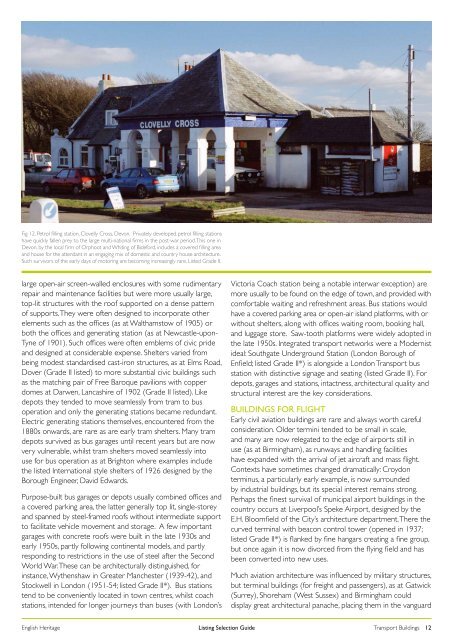Designation Listing Selection Guide: Transport ... - English Heritage
Designation Listing Selection Guide: Transport ... - English Heritage
Designation Listing Selection Guide: Transport ... - English Heritage
Create successful ePaper yourself
Turn your PDF publications into a flip-book with our unique Google optimized e-Paper software.
Fig 12. Petrol filling station, Clovelly Cross, Devon. Privately developed petrol filling stations<br />
have quickly fallen prey to the large multi-national firms in the post-war period. This one in<br />
Devon, by the local firm of Orphoot and Whiting of Bideford, includes a covered filling area<br />
and house for the attendant in an engaging mix of domestic and country house architecture.<br />
Such survivors of the early days of motoring are becoming increasingly rare. Listed Grade II.<br />
large open-air screen-walled enclosures with some rudimentary<br />
repair and maintenance facilities but were more usually large,<br />
top-lit structures with the roof supported on a dense pattern<br />
of supports. They were often designed to incorporate other<br />
elements such as the offices (as at Walthamstow of 1905) or<br />
both the offices and generating station (as at Newcastle-upon-<br />
Tyne of 1901). Such offices were often emblems of civic pride<br />
and designed at considerable expense. Shelters varied from<br />
being modest standardised cast-iron structures, as at Elms Road,<br />
Dover (Grade II listed) to more substantial civic buildings such<br />
as the matching pair of Free Baroque pavilions with copper<br />
domes at Darwen, Lancashire of 1902 (Grade II listed). Like<br />
depots they tended to move seamlessly from tram to bus<br />
operation and only the generating stations became redundant.<br />
Electric generating stations themselves, encountered from the<br />
1880s onwards, are rare as are early tram shelters. Many tram<br />
depots survived as bus garages until recent years but are now<br />
very vulnerable, whilst tram shelters moved seamlessly into<br />
use for bus operation as at Brighton where examples include<br />
the listed International style shelters of 1926 designed by the<br />
Borough Engineer, David Edwards.<br />
Purpose-built bus garages or depots usually combined offices and<br />
a covered parking area, the latter generally top lit, single-storey<br />
and spanned by steel-framed roofs without intermediate support<br />
to facilitate vehicle movement and storage. A few important<br />
garages with concrete roofs were built in the late 1930s and<br />
early 1950s, partly following continental models, and partly<br />
responding to restrictions in the use of steel after the Second<br />
World War. These can be architecturally distinguished, for<br />
instance, Wythenshaw in Greater Manchester (1939-42), and<br />
Stockwell in London (1951-54; listed Grade II*). Bus stations<br />
tend to be conveniently located in town centres, whilst coach<br />
stations, intended for longer journeys than buses (with London’s<br />
Victoria Coach station being a notable interwar exception) are<br />
more usually to be found on the edge of town, and provided with<br />
comfortable waiting and refreshment areas. Bus stations would<br />
have a covered parking area or open-air island platforms, with or<br />
without shelters, along with offices waiting room, booking hall,<br />
and luggage store. Saw-tooth platforms were widely adopted in<br />
the late 1950s. Integrated transport networks were a Modernist<br />
ideal: Southgate Underground Station (London Borough of<br />
Enfield; listed Grade II*) is alongside a London <strong>Transport</strong> bus<br />
station with distinctive signage and seating (listed Grade II). For<br />
depots, garages and stations, intactness, architectural quality and<br />
structural interest are the key considerations.<br />
BUILDINGS FOR FLIGHT<br />
Early civil aviation buildings are rare and always worth careful<br />
consideration. Older termini tended to be small in scale,<br />
and many are now relegated to the edge of airports still in<br />
use (as at Birmingham), as runways and handling facilities<br />
have expanded with the arrival of jet aircraft and mass flight.<br />
Contexts have sometimes changed dramatically: Croydon<br />
terminus, a particularly early example, is now surrounded<br />
by industrial buildings, but its special interest remains strong.<br />
Perhaps the finest survival of municipal airport buildings in the<br />
country occurs at Liverpool’s Speke Airport, designed by the<br />
E.H. Bloomfield of the City’s architecture department. There the<br />
curved terminal with beacon control tower (opened in 1937;<br />
listed Grade II*) is flanked by fine hangars creating a fine group,<br />
but once again it is now divorced from the flying field and has<br />
been converted into new uses.<br />
Much aviation architecture was influenced by military structures,<br />
but terminal buildings (for freight and passengers), as at Gatwick<br />
(Surrey), Shoreham (West Sussex) and Birmingham could<br />
display great architectural panache, placing them in the vanguard<br />
<strong>English</strong> <strong>Heritage</strong> <strong>Listing</strong> <strong>Selection</strong> <strong>Guide</strong><br />
<strong>Transport</strong> Buildings 12
















